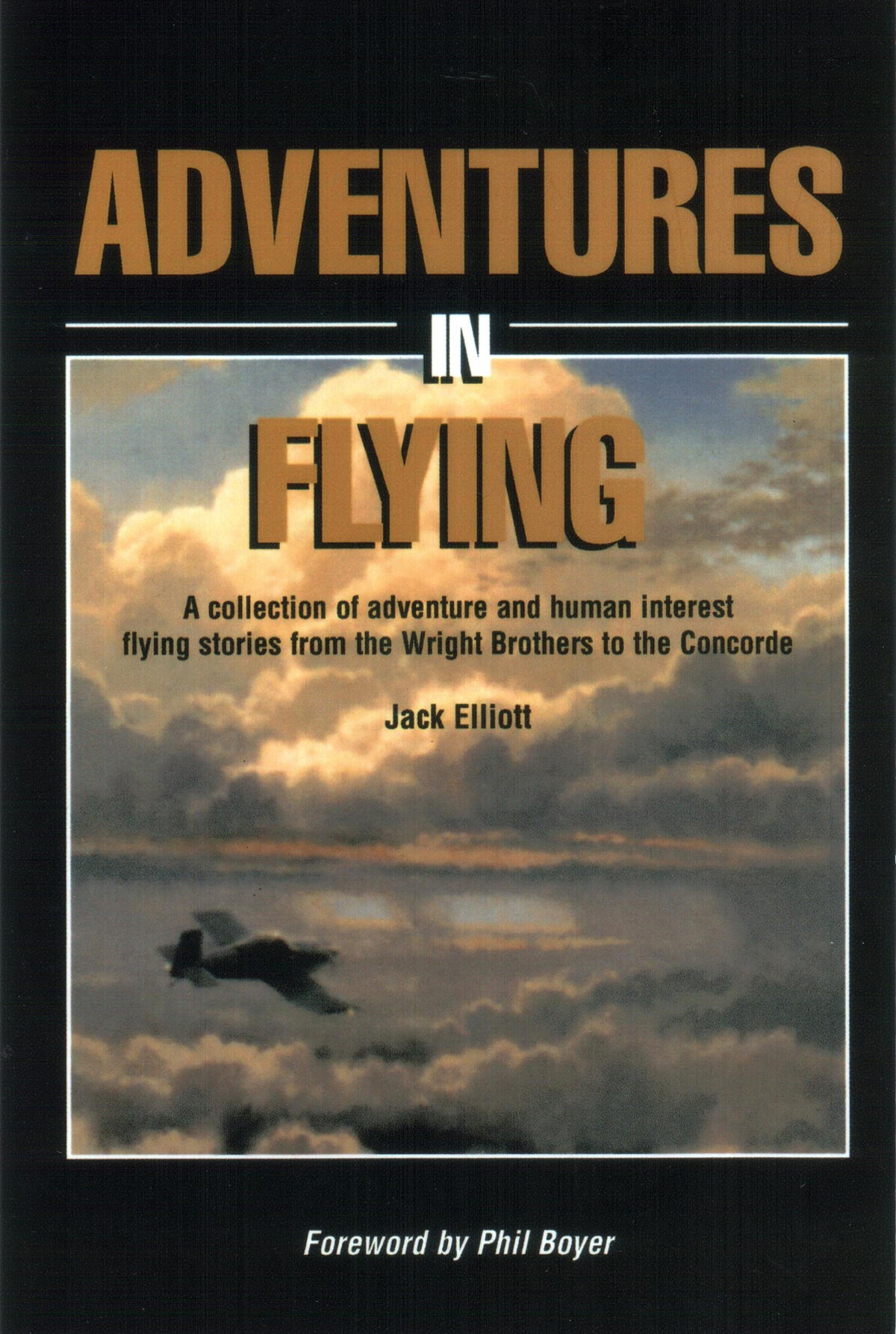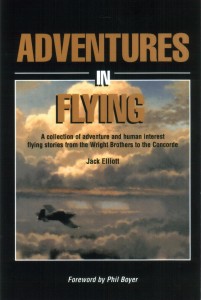
Adventures in Flying” is a collection of adventure and human-interest flying stories. It spans the Wright brothers to the Concorde and beyond. Some readers have compared it to Ernest Gann’s “Fate is the Hunter.”
By Henry M. Holden
Jack Elliott was 4 years old when the Graf Zeppelin flew over Brooklyn on its round-the-world flight. Everybody in the four-story building where Elliott lived ran up on the roof to watch except him.
“The image of that gigantic airship terrified me,” he said.
He did eventually see the huge ship flying away, when his mother coaxed him to come to the window. Elliott didn’t have the same fear of airplanes. They fascinated him.
“I had this feeling I just wanted to be up there, and I wondered what it was like to be flying,” he said. “It was like an irresistible force, a magnet, pulling me out of the house. Whenever I heard an airplane, I’d run out to the backyard to stare up at the sky. Even today, if I’m standing in a crowd talking, I have to look up.”
His mother encouraged Elliott’s fascination with flight, not knowing how involved he would become in aviation or that he would become an award-winning journalist. He most recent accomplishment is “Adventures in Flying,” recently published. The book is a collection of 140 human-interest stories involving virtually every aspect of flying, culled from Elliott’s 38 years of “Wings Over Jersey” columns, believed to be the longest running column ever devoted to flying.
First steps
Elliott recalled that his earlier fascination with airplanes led him to begin building balsa wood models. Although he dreamed of flying while he built the planes, he knew it was far-fetched. When he was 10, he took his first airplane ride.

Adventures in Flying” is a collection of adventure and human-interest flying stories. It spans the Wright brothers to the Concorde and beyond. Some readers have compared it to Ernest Gann’s “Fate is the Hunter.”
“My father, my younger brother and I flew in a New Standard out of Pine Brook Airport (NJ),” he said, remembering that the price of the ride was $3. “My brother, who was a sharp negotiator, asked the hawker selling the rides if we could both go for $3. He agreed.”
During World War II, Elliott served in the U.S. Army in a mortar battalion. He also had his first combat fight in a glider into southern France.
“My company had the ‘honor’ to fly into France on CG-4 gliders,” he said. “The rest of my outfit went in from the beaches. When they told us we were flying in, one of the men started running. I think he’s still running today.”
He said that many of the gliders crashed and some units lost up to three-quarters of their men, but his was lucky.
“We landed with some minor damage,” he said.
Elliott’s first job after his Army discharge was as a reporter for the Belleville Times in New Jersey. He worked for a year without a salary.
“I could go out two days a week and sell subscriptions door-to-door for two dollars,” he said. “The publisher got a dollar and I got the other dollar. I also got ten cents a line for covering sports. The editor was a wonderful person; he knew that I was working for virtually nothing so he padded things a little and gave me an additional ten cents an inch for covering high school sports.”
Flight lessons
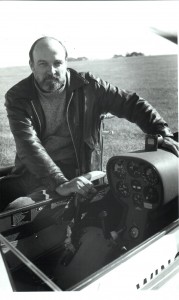
Author and journalist Jack Elliott received the FAA Wright Brothers Master Pilot Award for more than 50 years of safe flying. He’s also an inductee in the Aviation Hall of Fame of New Jersey.
Elliott went to the Long Island Press in 1949, because it had a training program for cub reporters. He also took his first flight lesson that year.
“I was living in New Jersey and went out to Westfield Airport and began taking flying lessons in a Piper Cub,” he recalled. “It was an incredible experience to sit in a real airplane, inhale the smell of oil, manipulate the controls, and feel the magical response.”
He vividly recalls an incident as he was preparing to solo.
“After the last landing of the day, on the turf strip, the instructor in the back of me—who usually spoke with a roar—leaned over and softly said, ‘I’m not sure, but I think you caught the prop.’ He was right,” Elliott said. “About an inch was missing from each end of the wooden propeller. They had another prop on the airplane before I left, but I felt so bad about the incident, I never went back.”
Five years later, Elliott had moved from the Long Island Press to the Star Ledger, in Newark, N.J. In 1954, he went back to flying.
“I went out to a flight school at Morristown Airport (MMU) and resumed my training,” he said. “I soloed in a Piper Super Cruiser, and got my license that year.”
Nine years later, Elliott was the Sunday editor at the Star Ledger. He suggested to his editor, Mort Pye, that the paper needed an aviation column and offered himself as the writer.
“He thought about it for a moment and said, ‘OK, try it,'” he recalled.
“Wings Over Jersey”
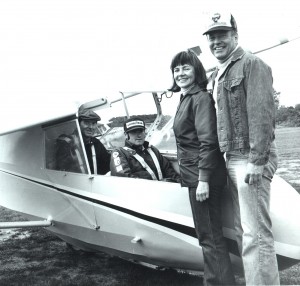
Ray Temchus was a pilot before an accident left him a quadriplegic. Today he’s a glider instructor and teaches other disabled people how to fly gliders.
For “Wings Over Jersey,” Elliott mainly interviewed Jerseyians, with some exceptions.
“I covered the Tuskegee Airmen, because they have an incredible story that deserved attention,” he said. “I wrote about Jimmy Doolittle, a man of integrity and my hero, and I wrote about other significant men and women in aviation. I also covered some unknown people like Florence Johnson, who wasn’t a pilot but was one of the first American women to go up in an airplane, in March 1911.”
The column ran from June 9, 1963, to Dec. 30, 2001. He said he wrote it for the “average reader,” not just pilots.
“I knew pilots would read it, but I wanted to cover all aspects of aviation and concentrate on adventure and human-interest stories that would appeal to a broad spectrum of readers,” he said.
Elliott wanted to educate the public. One of the ways he thought he could do that was to write about women in aviation, so a number of his early columns were about women.

Mary D’Angelo-Soble and her husband, Irv Soble, founded Freedom’s Wings International to teach the disabled to fly gliders. In the glider are Jay Donovan, front seat, who lost the use of his legs in an accident, and instructor Carl Fishler.
“I met some women in New Jersey who were members of the Women Airforce Service Pilots during the war,” he said. “They flew fighters and bombers from the factories to the air bases. The image back in 1963 was that men were more macho and that women were more delicate and intelligent and had better judgment. If women flew, people would think ‘Flying isn’t all that bad if women are doing it too.'”
Elliott wrote about people that few had heard of whose aviation exploits were overflowing with drama, suspense and excitement, rivaling the exploits of aviation’s greatest heroes.

Florence Johnson, a nonagenarian when Jack Elliott interviewed her, took her first airplane ride in March 1911. She later married the pilot, Walter Johnson. He eventually gave up flying, because it didn’t pay, and became a banker.
“I wanted to convey the feeling about the spirit of the people who fly, what makes them want to fly, and the advantages of flying,” he said.
He said that when he started writing the column, the average person thought of airplanes, but not gliders, ultralights and helicopters.
“I wanted to make that point clear. I don’t think many people knew of the contributions that so many pilots made, like Claudio Tonnini, who flew 18,000 miles in his RV-4,” he said. “The flight was an incredible display of courage.”
Elliott tried to present stories that would offer a well-rounded picture of the fascinating world of flying.
“Many of the people in my book are people who took the word ‘can’t’ and dropped the “t,” like John Joseph, who didn’t believe people when they said he couldn’t build a landing strip on top of a mountain,” he said. “He fooled them.”
Some of the most inspiring stories Elliott encountered were about people who overcame severe physical handicaps to become pilots.
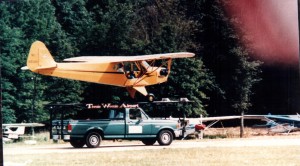
With the exception of the DC-3, no aircraft has had as long an active life as the J-3 Cub. Here, a Piper Cub is landing on the “world’s shortest runway,” a pickup truck at the Sussex County Airport (KWN) Air Show.
“Mary D’Angelo-Soble and her husband, Irv Soble, founded Freedom’s Wings International,” he said. “It was because of them that Ray Temchus, a quadriplegic, would go on to teach other disabled people to fly gliders. Jack Hughes couldn’t walk or talk, but he sky dives. I wanted to convey information as well as the emotional involvement of those involved.”
Every spring, usually the first three Sundays after Easter, Elliott would write a series of columns about learning to fly, interviewing various student pilots, young and more mature.
“I discovered that most people were shy about going into a fixed base operation and inquiring about flight lessons,” he said. “Since they didn’t know anything about aviation, they were afraid they’d sound like they were asking dumb questions. I decided to interview the students. I wrote a number of columns on the cost of lessons and showed that not all physical challenges rule out a person in getting a license. I also tried to relieve people of doubts about passing a medical.”
Elliott got letters from all over the country about the column.
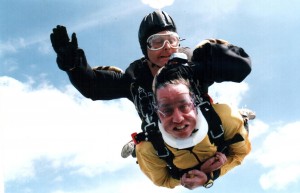
A victim of Lou Gehrig’s disease, Jack Hughes can’t walk or talk but he sky dives. Hughes, bottom, is in a tandem jump with his instructor, Pete Fiddler. His story is just one of dozens of inspirational tales in the book.
“I began to wonder how the people in Arizona, California or Ohio knew what I was writing here in New Jersey,” he said. “I found out that most of the letter writers once lived in New Jersey and their former neighbors or a relative would mail them the column.”
Elliott’s column came to an end a few years after a new editor came in from a big New York newspaper. The changes he requested included telling Elliott not to write about conflicts between communities and airports. Elliott eventually wrote his final column, in June 2001, and then waited for the right time to present it. He decided that was the last Sunday of that year.
“I just left it on the desk and walked out,” he said.
“Adventures in Flying”
Elliott said that people were encouraging him to compile the columns into a book as far back as 25 years ago.
“To write a book while I was still working would have been nearly impossible,” he said. “I wrote nearly 2,000 columns, and I didn’t have the time to decide which ones I wanted to use.”
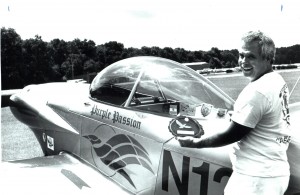
Claudio Tonnini calls his RV-4 The Purple Passion. He built and flew the airplane 9,000 miles to the tip of South America and then back. During the flight, he encountered monstrous, unexpected obstacles. His is a story of courage.
When he finally had the time to organize the material, he decided to include what he thought would be most significant for the average reader. Many of the astounding achievements recounted in the book transcend the world of flying, including examples of people achieving the impossible dream. One story is about a tractor-trailer driver who, against seemingly insurmountable odds, became a corporate jet pilot. Others in the book overcame severe physical handicaps and learned to fly. One persistent person built a worldwide multimillion-dollar business, which started with an investment of $1,000 in a used airplane.
Aviation Honors
The Aviation Hall of Fame of New Jersey inducted Elliott in 1986. He has earned a number of awards over the years, the most recent being the Mid-Atlantic Pilots Association Lifetime Achievement Award. He’s received journalism awards from the National Business Aviation Association and the National Air Transportation Association as well as an award from the Aviation/Space Writers Association and a Presidential Citation and the Max Karant Award for Lifetime Excellence in Aviation Coverage from the Aircraft Owners and Pilots Association.
The FAA presented Elliott with the Wright Brothers Master Pilot Award for more than 50 years of safe flying. He holds a commercial pilot’s license with instrument, glider and single-engine seaplane ratings and continues to write for several aviation magazines.
For more information, visit [http://www.adventuresinflying.net].











